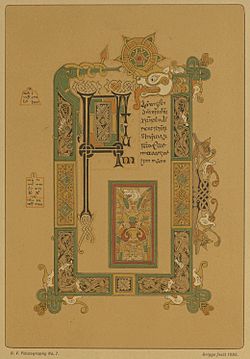Mac Durnan Gospels facts for kids
The Mac Durnan Gospels, also known as the Book of Mac Durnan, is a very old and special book. It's an illuminated Gospel book, which means it's a handwritten book of the Gospels with beautiful pictures and decorations. This book was made in Ireland around the late 800s or early 900s. It's a later example of Insular art, a unique style from Ireland and Britain.
What's interesting is that this book ended up in Anglo-Saxon England not long after it was created. Today, you can find it in the Lambeth Palace Library in London. The book contains the four gospels of Matthew, Mark, Luke, and John. It also has a full-page evangelist portrait for each of the four Gospel writers. There's even a special opening page with symbols for the four evangelists arranged around a cross. Some pages also have very fancy decorated letters at the beginning of sections.
Contents
The Book's Journey Through Time
We know a lot about the Mac Durnan Gospels' past from a special message written inside it. This message was added on page 3v. It suggests that Máel Brigte mac Tornáin (who died in 927) was involved in making or ordering the book. He was known as Mac Durnan and was an important leader of a monastery in Armagh, Ireland. The message says he dedicated the book to God.
The book likely left Ireland soon after it was made. It became a gift to King Æthelstan (who ruled from 924 to 939) in England. The message inside the book also says that King Æthelstan gave it to Christ Church, Canterbury, an important church. This shows us how connected King Æthelstan's court was with Ireland back then.
Later, around the 1000s, six Anglo-Saxon charters were copied into the book. These were like official documents or records of agreements from that time.
By 1574, the book was owned by Matthew Parker, who was the Archbishop of Canterbury. He probably added some small pictures from another old book (a Psalter) and gave the Mac Durnan Gospels its current cover. After he passed away, Parker left most of his old books to a college, but not this one. We don't know why, but he might have given it to a friend while he was still alive. The book eventually found its way to the Lambeth Palace Library, where it is kept today.
What's Inside the Mac Durnan Gospels?
The Text
The Mac Durnan Gospels contains the four Gospels from the Latin Vulgate Bible. They are written in a style called Irish minuscule script. This is a small, neat handwriting style. The text in this book is very similar to other famous old Irish Gospel books, like the Echternach Gospels and the Book of Armagh.
Here's what you'll find inside:
- F.5-69: The Gospel of Matthew
- f.69-70: Four old documents and two texts about Canterbury Cathedral from before 1050
- f.72-115: The Gospel of Mark
- f.117-170: The Gospel of Luke
- f.172-216: The Gospel of John
The Artwork and Decorations
The book starts with a special page that has a cross. Around the cross are the symbols of the Four Evangelists: an angel, an eagle, a bull, and a lion. Each symbol is in its own yellow or green frame. The cross itself is decorated with black and white Celtic knot patterns. These are swirling, endless designs. Along the cross, there are frames with the same knots mixed with red, yellow, and green diamond shapes.
The pictures of the evangelists are also decorated with similar colors and patterns.
- Saint Matthew (on page 4v) holds a stick and a book. His picture is surrounded by a frame made of woven patterns and knots.
- Saint Mark (on page 70v) holds a book. He is surrounded by crawling lions, which look like a throne he is sitting on. Above his head is an animal that looks more like a bull than a lion. This matches older ways of showing the evangelists, like in the Book of Durrow.
- Saint Luke (on page 115v) has a geometric-looking head. He holds a stick and a book.
- Saint John (on page 170v) holds a quill (an old pen) dipped in an inkwell and a book with another quill.
All the evangelists' pictures are framed with different Celtic knot designs and diamond shapes. The frames for Saint Luke and Saint John are almost identical. The first letters of each Gospel are also highly decorated with similar patterns.
Four small pictures from a 1200s English Psalter (another type of religious book) were added to the beginning of each Gospel. These pictures show important moments from the Bible:
- The Crucifixion at the start of Matthew.
- The Flagellation of Christ at the start of Mark.
- The Betrayal of Judas at the beginning of Luke.
- The Entombment of Christ at the beginning of John.
Images for kids






